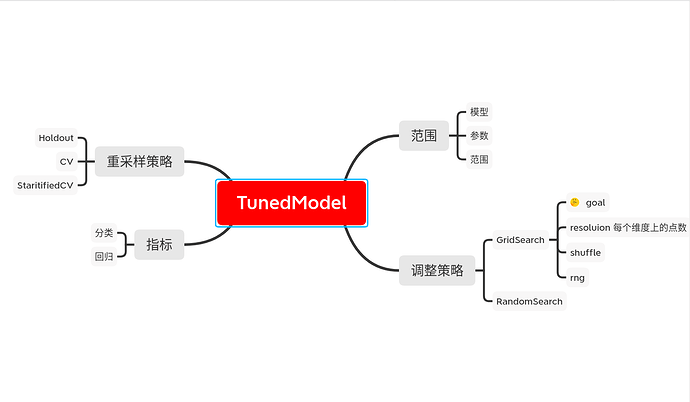1.什么是TunedModel
为了得到更好的模型,我们需要调试模型的参数
还好MLJ为我们提供了TunedModel,我们要做的就是把原来的模型包装起来,进行调试
self_tuning_model = TunedModel(model = model,
resampling = resampling,
measure = measure,
rannge = range,
tuning = tuning,
weights = weights)
self_tuning_mach = machine(self_tuning_model, train_features, train_labels)
2.怎么调优模型
最重要的是参数范围range,参数范围的搜索策略tuning和判断最优结果的指标measure
2.1 range
range需要指定model,model的参数:param,范围和取值(scale)
不过scale我不知道怎么回事,不懂,好像是取值规定,比如:linear是均匀,其他的比如:log我就不知道了
[数值]单个参数
r = range(model, :param, lower, upper, scale)
range = r,
[数值]多个参数
r1 = range(model, :param1, lower, upper, scale)
r2 = range(model, :param2, lower, upper, scale)
range = [r1, r2]
[特殊]
r1 = range(model, :param, values = [v1, v2, ...])
补充
如果没有指定scale的话
If scale is unspecified, it is set to :linear, :log, :logminus, or :linear,
according to whether the interval (lower, upper) is bounded, right-unbounded,
left-unbounded, or doubly unbounded, respectively. Note upper=Inf and
lower=-Inf are allowed.
ps: 其实range(model, :param, lower, upper, scale = :linear) 跟 range(model, :param, values = lower:upper)是一样的
2.2 tuning
tuning有两种策略,网格搜索和随机搜索
Grid(goal=nothing, resolution=10, rng=Random.GLOBAL_RNG, shuffle=true)
Instantiate a Cartesian grid-based hyperparameter tuning strategy with a
specified number of grid points as goal, or using a specified default
resolution in each numeric dimension.
具体可以看这篇文章
但是这些参数有点特别,我不懂goal的意思,google了半天也没找到,本来想用sklearn类比一下的,可是参数有点特别,希望有人能为我解答
ps: 从slack上作者给我的解释 resolution is number of points in each dim,还好我这个菜鸟问了这么多没把我弄死
RandomSearch(bounded=Distributions.Uniform,
positive_unbounded=Distributions.Gamma,
other=Distributions.Normal,
rng=Random.GLOBAL_RNG)
Instantiate a random search tuning strategy, for searching over Cartesian
hyperparameter domains, with customizable priors in each dimension.
2.3 measure
measure是为了衡量模型调整参数后的好坏而引入的指标,我们只讨论分类和回归的情况
文档在这里
ps: 也可以指定多个measure
weights
也可以指定权重,用数组向量表示
2.4 resampling
内置的重采样策略有三种,
Holdout: 将数据集分为train和test两部分,比例由fraction_train指定
CV: K折交叉验证
StratifiedCV: K折分层交叉验证
三种重采样方法都可以指定shuffle = true来指定,同时可以设定可重复使用的随机数种子
具体用法看这里
using StableRNGs
rng = StableRNG(1234)
3. 怎么得到最优模型
fit!(self_tuning_mach)
best_model = fitted_params(sefl_tuning_mach).best_model
4. 接下来的工作
如果我们对这个模型有疑问怎么办?
我们可以对这个最优模型进行评估,或是通过learning_curve来观察训练过程
当然,evaluate和learning_curve会单独写文档,因为内容有点多
5. 贴个代码试试
5.1 先试试单个参数调整
using MLJ
X = MLJ.table(rand(100,10))
y = 2X.x1 - X.x2 + 0.05 * rand(100)
tree_model = @load DecisionTreeRegressor
# 调整单个参数
r = range(tree_model, :min_purity_increase, lower = 0.01, upper = 1.0, scale = :linear)
self_tuning_tree_model = TunedModel(model = tree_model,
resampling = CV(nfolds = 3),
tuning = Grid(resolution = 10),
range = r,
measure = [rms, l1]
self_tuning_tree = machine(self_tuning_tree_model, X, y)
fit!(self_tuning_tree)
best_model = fitted_params(self_tuning_tree).best_model
这是tree_model
julia> tree_model
DecisionTreeRegressor(
max_depth = -1,
min_samples_leaf = 5,
min_samples_split = 2,
min_purity_increase = 0.0,
n_subfeatures = 0,
post_prune = false,
merge_purity_threshold = 1.0) @371
这是best_model
julia> best_model = fitted_params(self_tuning_tree).best_model
DecisionTreeRegressor(
max_depth = -1,
min_samples_leaf = 5,
min_samples_split = 2,
min_purity_increase = 0.01,
n_subfeatures = 0,
post_prune = false,
merge_purity_threshold = 1.0) @408
好吧,好像没什么变化
5.2 再试试多个参数调整,顺便强化一下tree_model,进化成forest
没办法,我没系统学过决策树,不知道里面的参数含义
forest_model = EnsembleModel(atom = tree_model)
r1 = range(forest_model, :(atom.n_subfeatures), lower = 1, upper = 9)
r2 = range(forest_model, :bagging_fraction, lower = 0.4, upper = 1.0)
self_tuning_forest_model = TunedModel(model = forest_model,
tuning = Grid(resolution = 10),
resampling = CV(nfolds = 6),
range = [r1, r2],
measure = rms)
原来的forest_model
julia> forest_model
DeterministicEnsembleModel(
atom = DecisionTreeRegressor(
max_depth = -1,
min_samples_leaf = 5,
min_samples_split = 2,
min_purity_increase = 0.0,
n_subfeatures = 0,
post_prune = false,
merge_purity_threshold = 1.0),
atomic_weights = Float64[],
bagging_fraction = 0.8,
rng = Random._GLOBAL_RNG(),
n = 100,
acceleration = CPU1{Nothing}(nothing),
out_of_bag_measure = Any[]) @723
最优模型
julia> best_model = fitted_params(self_tuning_forest).best_model
DeterministicEnsembleModel(
atom = DecisionTreeRegressor(
max_depth = -1,
min_samples_leaf = 5,
min_samples_split = 2,
min_purity_increase = 0.0,
n_subfeatures = 9,
post_prune = false,
merge_purity_threshold = 1.0),
atomic_weights = Float64[],
bagging_fraction = 0.8,
rng = Random._GLOBAL_RNG(),
n = 100,
acceleration = CPU1{Nothing}(nothing),
out_of_bag_measure = Any[]) @027
娘的,好像还是没什么变化
6. 疑问
- 在指定
range时,scale的作用 - 调整策略
tuning中Grid的参数,Grid对训练模型个数的影响 - 这个论坛怎么创建目录??
